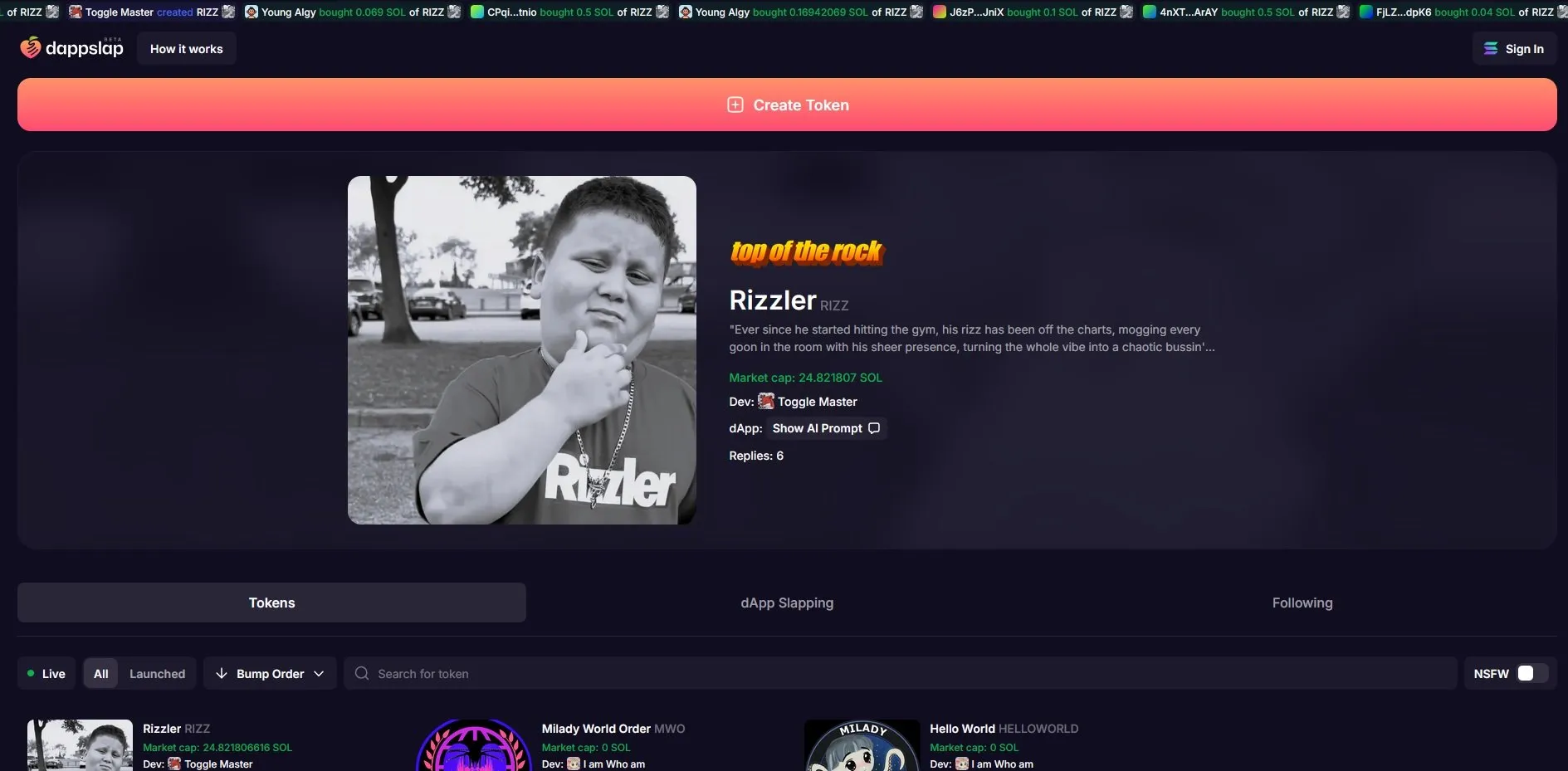
A new token launchpad on Solana will enable users to create decentralized applications (dapps) using just an AI prompt.
Launching on September 10, dappslap is a “marketplace for ideas,” founder Troy Murray told Decrypt.
Users can quickly launch a dapp using an AI prompt, and if the dapp escapes a bonding curve, the prompt gets put into an AI generator and created. The idea, Murray explained, is that “the best ideas will escape the bonding curve,” similar to how meme tokens are created on launchpads like pump.fun.
The process for spinning up a dapp on dappslap is simple: navigate to its website, sign in with your wallet, pay a 0.02 SOL fee, and submit a prompt. Like Pump.fun, a bonding curve is created when an idea is submitted to the marketplace. Users can buy tokens from the bonding curve, and when it maxes out, the idea is given to the AI generator and created.
Once live, the tokens purchased from the bonding curve are used as governance tokens to govern the new app that has been created. “In just a few clicks you get a website sign-in for your dapp, a frontend, and a Solana Rust contract connected to a DAO in our interface,” said Murray.
Dappslap creates a governance dashboard for all fully bonded ideas, where token holders who support the idea can collaborate and make decisions regarding the future of the dapp. The DAO also automatically collects trading fees from the governance token to fill its treasury. “On pump. fun when a token escapes the bonding curve, it gets put into Raydium, and those fees get burned,” Murray explained. Instead, dappslap turns the pool over to a DAO that controls the dapp being created. That means the DAO is funded by trading fees generated by its token and whatever revenue the AI-generated dapp it manages may or may not generate.

Once an idea escapes the bonding curve, 4.2% of the token supply is locked for one year. Murray argued that other platforms with similar mechanics suffer from misaligned incentives that can hurt users and that dappslap can improve upon them.
Users on dappslap don’t have to create a dapp or submit an idea to use the platform; they can also browse the idea marketplace and purchase tokens from whichever ideas they think should be made.
To create dappslap, its team trained an LLM on Web3 data, including open GitHubs, all the available APIs, and SDKs. With this information, the AI can create Dapps and plug them into all the endpoints necessary for them to function as intended.
The origin of dappslap
Dappslap and its founders are no strangers to the world of crypto. Troy Murray previously helped found BarnBridge, a DeFi protocol that reached a settlement with the SEC in 2023 over unregistered securities sales.
During the process of negotiating the settlement, the SEC initially stipulated that none of the team members would be able to work in Web3 again once the case had concluded. At the time, the dappslap team was working on a Web3 streaming service called Xeenon, which they had to scrap completely—a decision Murray described as “gut-wrenching.”
“You dedicate the last seven years of your life to an emerging technology that you think will change the world, and the state has the power to strip all that from you,” Murray told Decrypt, adding that, “You start to question yourself.”
Murray and his team pivoted to AI, developing an AI app generator to generate Web2 applications based on a prompt. Ultimately, the SEC settlement didn’t bar the team from working in Web3, enabling them to rework their AI app-building product to focus on dapps and integrating with Web3 protocols.
What’s next for dappslap?
Following dappslap’s launch, it’s planning to develop new features including a “Front End Manipulator.” The tool will enable people launching dapps to edit the frontend using AI, and will distribute fees to users who create frontends depending on how many people use them.
Dappslap is also working on functionality that would allow token holders in the DAO of any dapp to use AI to write proposals to change the project. This would allow people who don’t have a deep technical understanding to participate in DAO governance in ways they can’t in the traditional structure, where tech-savvy DAO members are relied upon to submit proposals.
Further down the line, said Murray, dappslap expects users to be able to build “much more complex dapps and much more complex systems for those dapps, and probably better frontends” as AI models improve. “Some of that is going to be on us—we're going to have to refine the AI agent system that's building it,” he said, adding that, “Some of it will also depend on getting smarter AIs. The best news is that this, currently, is the dumbest AI you'll ever use. It's only going to get smarter.”
To find out more about dappslap—and create your own dapp—head to dappslap.ai.